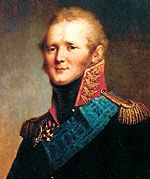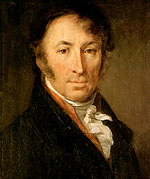History of the Manuscript
In its history, the Laurentian Codex has changed owners many times. Once, the book was kept at the Annunciation Monastery in Nizhny Novgorod, and then it belonged to the Christmas Monastery in Vladimir. This is evidenced by the inscription seen on the first folio, dated on paleographic grounds from the late 16th to the early 17th century, which reads, 'The Book of the Christmas Monastery in Vladimir'.In the 18th century, the manuscript was held in the collections of the St. Sophia Cathedral in Novgorod, where, in 1765, the Novgorod Seminary students made a copy of it (now this copy is housed in the Library of the Russian Academy of Sciences in St. Petersburg under the shelfmark 34.2.32). In 1791, together with other manuscripts, Laurentian Codex was transferred from Novgorod to Moscow and was acquired by Attorney-General of the Synod, Count Alexei Musin-Pushkin (1744-1817) who was well known not only as a Russian statesman, but as a historian, archaeographer, a passionate collector of manuscripts and antiquities.
Since then, the Laurentian Codex was put into scientific research. In 1793, A.Musin-Pushkin published Instruction of Vladimir II Monomakh that was a part of the Laurentian Codex. The famous historian Nikolai Karamzin made an extensive use of the landmark while writing the History of the Russian State (Karamzin called the manuscript as "Pushkin Codex" after the name of the owner). In 1804 the Society of Russian History and Antiquities of the Moscow University undertook the first edition of the text of the Laurentian Codex, but the work was aborted in 1810. Only the initial part of the text of the manuscript was issued (up to the year of 907). In 1810, it was decided to publish the Laurentian Codex according to the new plan, but this plan was not implemented.
In 1811, Musin-Pushkin had presented the valuable manuscript as a gift to Emperor Alexander I who gave it to the Imperial Public Library (now the National Library of Russia). In the archives of the Library, a cover letter "On acceptance of the Nestor's Chronicle for the collections of the Imperial Public Library", signed by Count Aleksander Stroganov and addressed to the Library Director Aleksei Olenin (Shelfmark: OAD NLR. F. 1. Op. 1, 1811 D. No. 9) has survived. This letter is dated 27 August 1811, and was received by the Library on 3 September of the same year. The letter required 'to accept for collections of the Imperial Public Library the Nestor's Chronicle presented to His Imperial Majesty by Actual Privy Councillor Count Musin-Pushkin, ... in the performance of the Imperial will'.
The favorable circumstance that the Laurentian Codex had been presented by Musin-Pushkin to the emperor and placed in the Imperial Public Library, miraculously saved the precious manuscript from imminent destruction - the count's magnificent collection of antiquities and manuscripts was irrevocably lost in the Moscow fire of 1812.

Note signed by A. Olenin's hand
And today, as you can see on the last folio of the Laurentian Codex, there is a note signed by A. Olenin's hand, 'This book donated by the late Count Aleksei Ivanovich Musin-Pushkin to the Imperial Public Library contains one hundred seventy-three labeled folios. Director of the Imperial Public Library Alexei Olenin'. The note was written no earlier than February 1817, after the death of Musin-Pushkin.
As the oldest extant source on the ancient history of the Slavs and Russia, the Laurentian Codex opens the Complete Collection of Russian Chronicles and is traditionally included in the first volume of this series. This volume was reissued several times. The first edition was produced in 1846 under the editorship of J. Berednikov. The edition consists of the original texts of the Laurentian Codex, but with variant readings from the Hypatian and Radzivill Chronicles, as well as, from the Khlebnikov Manuscript, and fragments of the Trinity Chronicle. The Hypatian and Khlebnikov Manuscripts were excluded from the second edition of 1872 as a separate group of chronicles. In 1872, the Archaeographical Commission prepared for publication the lithographed edition of the initial part of the Primary Chronicle from the Laurentian Codex. The third edition of the Laurentian Codex of 1897 was a reprint of the second. The fourth edition was edited by Academician E.F. Karsky and appeared in 1926. It includes discrepancies found primarily in the Radzivill Chronicle, particularly within the Moscow-Academic and Trinity Chronicles. The fourth edition was reproduced by phototype twice: in 1962 under the supervision of Academician M.N. Tikhomirov and in 1997 with a preface by B.M. Kloss.
The prime importance of the Laurentian Codex is illustrated by the fact that it was chosen by the outstanding Russian scholar Dmitry Likhachev as the main resource to prepare the academic publication of the Primary Chronicle in 1950 in the "Literary Monuments" series. The Primary Chronicle from the Laurentian Codex has become a textbook material for the study of Old Russian history and literature in the middle and high school.
The text of the Laurentian Codex has been explored carefully by well-known chronicles and source researchers. Among them are A. Shakhmatov, A. Nasonov, M. Priselkov, I. Tikhomirov, D. Likhachev, V. Komarovich, J. Lurie, B. Kloss, N. Rusinov and others (see Bibliography). However, the manuscript itself was rarely the subject of special study. Perhaps, the only scholar to draw attention to the codicological features of the manuscript and described them carefully is the G. Prokhorov, who has formed convincing concept of the history of the manuscript 's creation based on his keen observations.
As a national treasure, the Laurentian Codex is now secured in a highly restricted access store togerther with other extremely valuable items of the Manuscripts Department of the National Library of Russia. The text of the landmark has long been available in numerous publications: academic, scientific, popular scientific, educational. But the original itself is taken out of a special case primarily to ascertain its safety. The modern facsimile edition of Laurentian Codex is not possible due to technical difficulties in the adequate printing reproducing leaves of ancient manuscripts.
This project on the electronic reproduction of the landmark aims to fill this gap.






